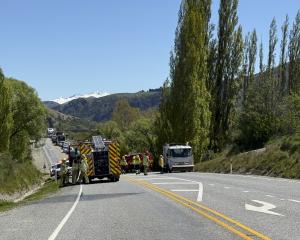A Chinese tourist who remained trapped and undetected under an overturned jet-boat drowned before rescuers could "reasonably" determine that a passenger was missing, a Transport Accident Investigation Commission report has found.
The report, released on Thursday, said the driver had no way of knowing if anyone was still trapped under the hull.
"By the time help arrived, and with it the first opportunity to make a head count, it is highly likely the deceased had already succumbed," it said.
Yan Wang (42) died and six people were injured (one moderate, five minor) when a Kawarau Jet boat carrying 22 passengers flipped on the Shotover River on September 25, 2008.
Ms Wang's body was found under the upturned hull 90 minutes after the boat overturned. Investigator-in-charge Iain Hill's report said "unnecessary delays" occurred in accounting for all the passengers but they did not contribute to her death.
His report found there was sufficient space under the overturned boat for the driver and passengers to escape.
However, Ms Wang could have been trapped, disoriented, have inhaled water or her lifejacket could have forced her up under the hull.
The majority of the passengers were not English speakers and said later they had not understood the safety briefing. Many could not remember seeing the safety card and they were not assisted in fitting their lifejackets, "although, in this case, the delivery of the pre-trip safety briefing did not affect the outcome of the accident", Mr Hill said.
He recommended lifejackets should be properly fitted and the drivers should take time to ensure passengers understood the briefing, rather than performing it in a "robotic fashion".
The report said the jet-boat touched an exposed shingle bar at the confluence of the Shotover and Kawarau Rivers while making a high-speed turn, causing it to roll over and come to rest upside down.
It found that another fully loaded jet boat, travelling upstream, had crossed ahead and had caused the water to be drawn from the shingle bar, exposing it in front of the oncoming boat. This effect had not been considered in safety planning or driver training.
Many of the passengers were thrown out of the boat and floated down river. Others were trapped underneath but managed to work themselves free or were helped out.
The driver checked both sides of the boat to see if any other passengers were still trapped underneath but could not see any.
The driver of the other jet-boat on the river dropped off his passengers on one of the exposed sand bars, picked up passengers from the water and transported them back to the sand bar.
"The two drivers attempted to carry out a head count. They had difficulty because the passengers from the two jet-boats ... were mingling. The passengers were later to say that some were aware that one was missing, but had some difficulty relating that information to the drivers," the report said.
Once one passenger was identified as missing, aerial searches were carried out but Ms Wang's body was not found until a heavy-lift helicopter arrived to raise the boat.
The driver, Ian Morgan (36), had been driving jet-boats for about seven years.
"The driver was one of the most experienced drivers employed by Kawarau Jet at the time and regularly acted as driver training instructor, peer reviewer and mentor for the less experienced drivers," the report said.
The weather conditions, river level and the jet-boat itself were cleared as having contributed to the crash.
The accident demonstrated the risks inherent in operating high-speed jet-boats on braided rivers, the report said. Maritime New Zealand had recommended that roll bars are fitted to commercial jet-boats operating on braided rivers, in the Government's major review of safety in adventure tourism.
Mr Hills' report recommended operators give "meaningful" pre-trip safety briefings to inform passengers of the inherent risk and address the issue of accounting for passengers when more than one boat was involved.
Kawarau Jet had made changes to its operating policies, including no longer crossing the bar, and requiring drivers to steer straight on to any bars or banks which cannot be avoided, to minimise the risk of flipping.
It also gives safety briefings before the boat is cast off to ensure everyone is paying attention and with cards in the appropriate language.
Kawarau Jet director Shaun Kelly was happy with the report.
"It is exactly what we thought about how the accident was caused, by another boat going past and creating a wash and drawing water off the bar. Taic has come to the same conclusion," he said.
Changes to its operating procedures were put in place immediately after Ms Wang's death, including extra radio calls between drivers at that point in the river, and pictorial safety cards for anyone not speaking English.
The company had meetings with the emergency services and other jet-boating companies to improve emergency procedures, he said.
"It was a tragic accident. Not a day goes by that I don't think about it," he said.












